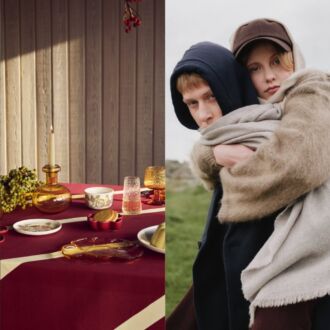Christmas is the most traditional of Finnish festivals. It is a time for family, close relatives and friends, and of course Christmas is many children’s favourite holiday.
While numerous new recipes have also found their way into the mix in many homes, the good old traditional dishes appear on the Christmas dining table year after year.
Freshly salted salmon
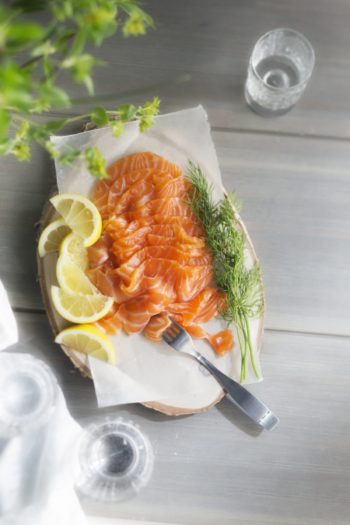
Freshly salted salmon requires no sauce.Photo: Mirva Kakko/Otavamedia/Lehtikuva
Preparation time: about 25 minutes
Salting time: 1–2 days
Not suitable for freezing
- Large piece of salmon, about 4 1/2 lb. (2 kg)
- 2 tablespoons coarse salt
- 1–2 tablespoons sugar
- 1 tablespoon roughly ground white pepper
- plenty of fresh dill
1. Fillet the salmon unless bought already filleted. Do not, however, remove the skin.
2. Wipe the fillets with paper towels without rinsing.
3. Sprinkle the bottom of a suitable sized dish with salt and place one of the fillets, skinside down, on the salt. Spread the seasoning over both the fillets, placing the other fillet, skinside up, on top. Sprinkle the rest of the salt and the dill over the fish. Cover the dish tightly with aluminium foil. Put a small weight on top and store in a cool place.
4. Scrape off all the seasoning and cut the fillets down to the skin into thin, oblique slices before serving.
Hint
Freshly salted salmon does not require any sort of dressing, especially when served at Christmas. However, mustard dressing goes very well with this dish.
Prepare as follows just before serving the salmon: Mix together 3 tablespoons of dark mustard, 2 tablespoons sugar and 4 tablespoons wine vinegar. Add 3/4 cup (2 dl) oil, preferably olive oil, in a thin stream while beating at the same time. Last of all, mix in plenty of finely chopped fresh dill.
Rosolli salad
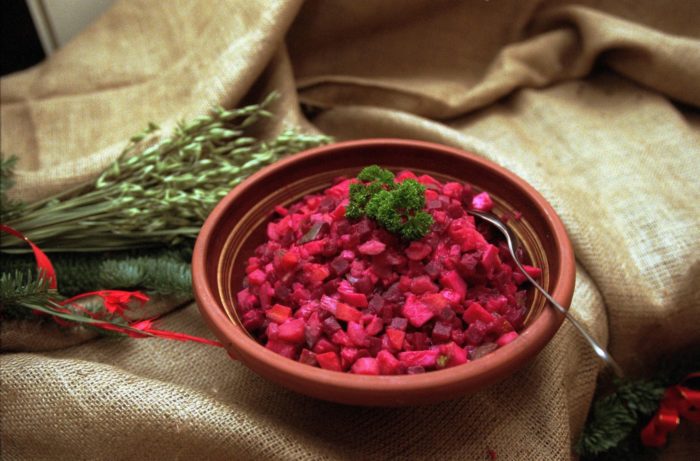
Rosolli is a name for a salad based on pickled beetroot.Photo: Sari Gustafsson/Lehtikuva
- 4 boiled potatoes
- 4 boiled carrots
- 4 boiled or pickled beetroot
- 1 gherkin
- 1 small onion, salt, white pepper
Dressing:
- 1 dl cream
- 1 tsp vinegar (10%)
- 1 tsp sugar
- (water the beetroot was cooked in)
Cook the vegetables (except for the onion!) in their skin well beforehand until just tender. Peel the vegetables and onion and cut them with the gherkin into small, equal-sized cubes. Mix them together and season with a little salt and white pepper.
Whip the cream lightly, season with sugar and vinegar and add a few drops of beetroot liquid for colour. Serve the dressing separately. (You can garnish the salad with hard-boiled eggs, the yolks and whites chopped separately and laid in stripes on the top.)
Casseroles
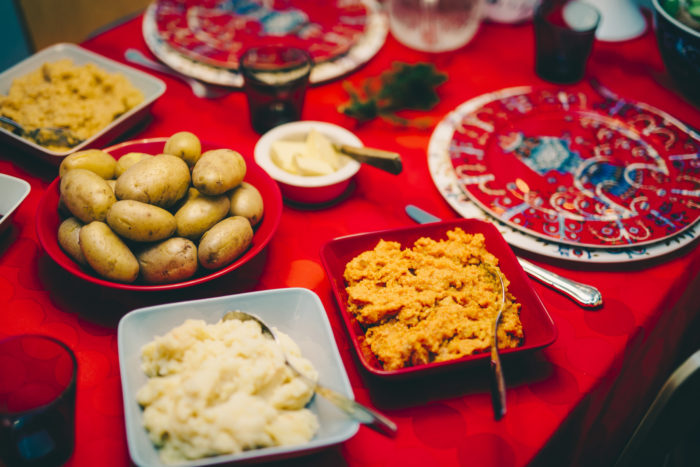
Casserole dishes made from carrots, rutabagas and potatoes are tasty and easier to prepare than you might think (and boiled potatoes are ever-present). Photo: Jussi Hellstén/Visit Finland
Casserole dishes form the main hot dishes served at Christmas. They are very useful from the hosts’ and hostesses’ point of view because they can be prepared well in advance. They keep well for two or three days when stored in a cool place.
Homemade casseroles are nutritious and much easier to prepare than you would imagine, and also exceptionally economical.
Rutabaga casserole
Preparation time: 25–30 minutes
Boiling time for the rutabagas: 30–40 minutes
Cooking time: 1/2–2 hours
Oven temperature: 350°F (175°C)
Suitable for freezing
- 2 large rutabagas, 3 1/2 lb. (about 1 1/2 kg)
- 1 1/2 cups (4 dl) cream or mixture of cream and milk
- 3/4 cup (2 dl) dried breadcrumbs
- 1/3 cup (1 dl ) dark syrup
- 1 egg
- 1 1/2 teaspoon ground ginger
- 1/2 teaspoon white pepper
- 1/2 teaspoon grated nutmeg
- 1 tablespoon salt
Coating: dried breadcrumbs, butter
1. Scrub and peel the rutabagas. Cut up into large pieces and boil in slightly salted water until soft.
2. Strain, keep the cooking liquid, and mash or blend the rutabagas in a kitchen blender.
3. Mix in the cream and dried breadcrumb paste, dark syrup, beaten egg and spices, and as much of the cooking liquid as is needed to give a loose soft consistency.
4. Turn into a greased baking dish, press the surface with a fork to make a pattern, sprinkle over a thin coating of dried breadcrumbs.
5. Dot the top with butter and bake in the oven.
Note: The flavour of the rutabaga casserole can be further enhanced by adding some lightly fried, grated onion.
Carrot casserole
Preparation time: 40 minutes
Cooking time: 20 minutes + 1 1/2 hours
Oven temperature: 350 °F (175°C)
Suitable for freezing
- 3/4 cup (2 dl) rice
- 1 1/2 cups (4 dl) water
- 1/2 cup (1.2 dl) milk
- 3 teaspoons salt
- 3 lb. (1 1/2 kg) carrots
- 3/4 cup (2 dl) milk or a mixture of cream and milk
- 1/4 cup (50g) butter
- 3 eggs
- 1 teaspoon grated nutmeg
- 1 tablespoon sugar
- 2 teaspoons salt
Coating: dried breadcrumbs, butter
1. Boil the rice in the water and milk mixture and cook until the rice starts to thicken just a bit.
2. Peel and grate the carrots.
3. Mix the grated carrots, milk, melted butter, eggs and spices into the rice pudding.
4. Pour the mixture into a greased baking dish. Sprinkle with dried breadcrumbs and dot with butter. Bake in the oven until brown all over.
Glass Masters herring
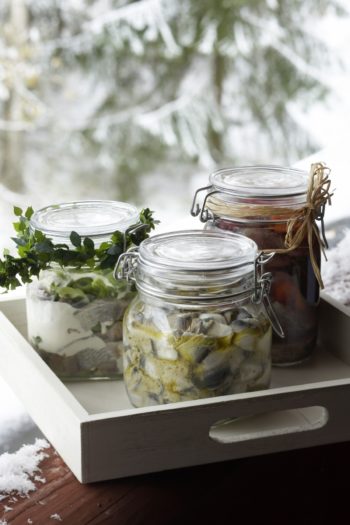
You may see several different varieties of marinated herring on the table at Christmastime.
Photo: Jarmo Wright/Otavamedia/Lehtikuva
Preparation time: 30 minutes
Soaking time: 12 hours
Marinading time: 2–3 days
- 4 good-sized herrings
- 3 red onions
- 2 carrots
- 30 whole allspice and white peppercorns
- 4 bay leaves
Marinade:
- 1 1/4 cups (3 dl) vinegar
- 1 1/4 cups (3 dl) sugar
- 2 1/2 cups (6 dl) water
1. Soak the fish overnight in cold water or equal portions of water and milk. The liquid can be changed occasionally.
2. Prepare the marinade; boil up all the ingredients and leave to cool at room temperature.
3. Remove the gut and inside belly membrane with, for instance, kitchen scissors. Rinse well and dry with paper towels. Cut up into shortish sections.
4. Peel the onions and carrots and cut into rings.
5. Fill a suitable glass jar with alternate layers of fish slices, onions and carrots, and the spices. Pour over the liquid.
6. Cover the jar and store in a cool place for at least two days. The herrings will keep for a couple of weeks in a cool place, but they are at their best after four to five days.
Hint
Different spices can also be used: thin slices of horseradish or celery seeds or mustard seeds. The fish can also be filleted and the skin removed. In that case, soaking is not required.
Baked ham
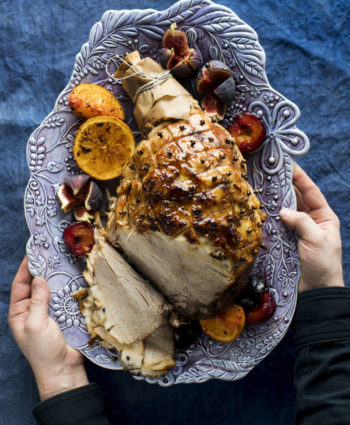
Baked ham is a Christmas mainstay for non-vegetarians.
Photo: Pekka Holmström/Otavamedia/Lehtikuva
Preparation time: 10 minutes
Cooking time: 45–55 minutes/2 lb. (1 kg)
Oven temperature: 250–300 °F (125–150°C) and 440°F (225°C)
- Ready-salted ham 10–15 lb. (5–8kg)
Coating:
- 2–4 tablespoons mustard
- 2–4 tablespoons brown sugar
- 2–4 tablespoons dried breadcrumbs
cloves for decorating
1. Place ham on a wiregrid in the roasting pan, skin side up. Push a roasting thermometer into the thickest part of the ham, making sure it does not touch the bone.
2. Put the ham in the oven. It is difficult to give a precise roasting time. It is best to go by the roasting thermometer. When it reaches 170 °F (77°C) the meat is cooked.
3. Remove from the oven and let it stand for a moment. Remove the skin and as much of the underlying fat as required.
4. Mix together the ingredients for the coating and smear over the ham. Put back into the oven at 440 °F (225°C) for ten minutes or until golden brown all over. Decorate the surface of the ham with cloves.
Note: If the ham is cooked at a lower temperature, less liquid will be lost and the meat will be much more succulent. Of course the lower the temperature, the longer the cooking time.
Variation
Many people consider that the meat will be much juicier if the ham is covered with a pastry crust. Prepare the pastry by mixing about 2 cups (800 g) rye flour in one litre of water. The pastry is then rolled out or patted over the surface of the ham to give a crust about 1/2 inch (1 1/2 cm) thick. No salt should be added to the pastry. If the ham happens to be too salty, the pastry crust will absorb the excess salt.
Hint
The meat juices that collect in the roasting pan can be used to make a tasty gravy. Be careful, however – it will be rather salty. One well-tried method is to mix in some applesauce flavoured with ground ginger and mustard, and serve together with the warm ham.
Rice porridge
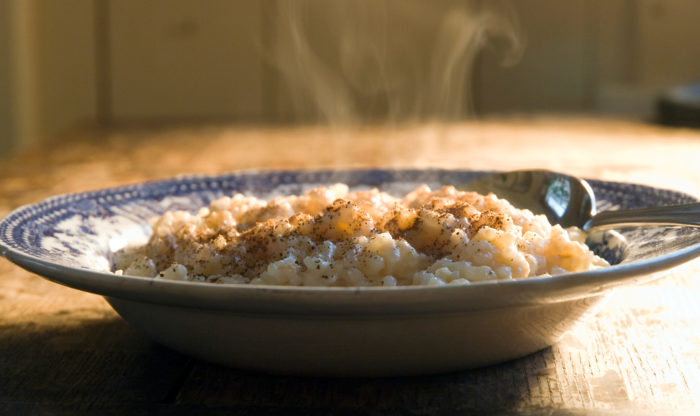
For Finnish people, the holiday season is not complete without rice porridge.
Photo: Ingela Nyman/Vastavalo/Visit Finland
(for 10 people)
Preparation time: 10 minutes
Cooking time: 40 minutes
Suitable for freezing
- 2 cups (1/2 litre) water
- 6 cups (1 1/2 litres) milk
- 1 1/4 cups (3 dl) rice
- 1 1/2 teaspoons salt
- 1 blanched almond
1. Add the rice to the boiling milk and water mixture.
2. Simmer until cooked. Add the salt and one blanched almond. Serve with ground cinnamon, sugar to taste, and milk.
Note: The almond is believed to bring good luck to the person who happens to get it.
Mixed fruit soup
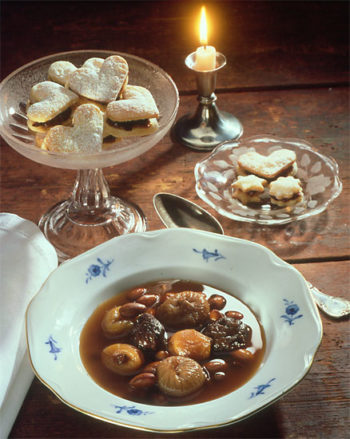
Fruit soup is a rare delicacy, but is not complicated to prepare.
Photo: Studio Fotoni
Preparation time: 5 minutes
Soaking time: overnight
Cooking time: about 15 minutes
- about 1 lb. (400g) dried mixed fruit
- 8 cups (2 litres) water
- 3/4 cup (1 1/2 dl) sugar
- stick of cinnamon
- (dash of salt)
- 3 tablespoons potato starch
1. Rinse the mixed fruit in cold water and leave to soak overnight in water containing a little sugar.
2. Boil the fruit in the soaking liquid with the cinnamon and a touch of salt if desired.
3. Continue to boil over a low heat until the fruit is fully cooked.
4. Transfer the fruit with a slotted spoon to the serving dish and remove the stick of cinnamon.
5. Thicken the juice: remove the pan from the heat, mix the potato starch in a little cold water and add in a thin stream to the liquid, stirring continuously. Bring quickly back to the boil without stirring.
6. Pour over the fruit and sprinkle a little sugar over the top.
Christmas bread

Tastes such as orange peel and caraway are found in this unusual, slightly sweet bread served only around the Christmas season.
Photo: Jarmo Wright/Otavamedia/Lehtikuva
(makes 3 loaves)
Preparation time: 30 minutes
Rising time: 1 1/2 hours altogether
Baking time: about 40 minutes
Oven temperature: 400 °F (200 °C)
Suitable for freezing
- 4 cups (1 litre) buttermilk
- 2 oz. (50 g) yeast
- 3/4 cup (2 dl) dark syrup
- 2 tablespoons grated orange peel
- 1/2 tablespoon roughly ground caraway seeds
- 1 tablespoon salt
- about 3 cups (8 dl) rye flour
- 1 1/2 cups (4 dl) graham flour
- about 4 cups (1 litre) white flour
1. Warm up the buttermilk.
2. Crumble in the yeast and add the syrup and spices.
3. Mix in the flour and knead thoroughly. Cover with a cloth and leave to rise. If the kitchen is drafty, stand the covered bowl in warm water.
4. Divide the dough into three and shape each portion into a round loaf. Put in a warm place to rise. Prick with a fork before placing in the oven.
Christmas pastries / Joulutortut
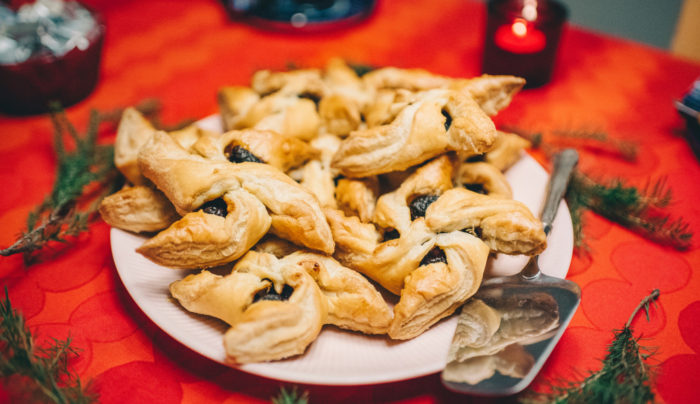
These fluffy, star-shaped pastries are available at every store and café in Finland during November and December.
Photo: Jussi Hellstén/Visit Finland
Pastry:
- 7 oz (200g) soft butter or margarine
- 1 cup (2 1/2 dl) flour
- 1/3 cup (1 dl) cold water
- 1 teaspoon vinegar
Filling:
- sweetened prune puree or plum jam
1. Put all the pastry ingredients into a bowl and mix quickly by hand into a dough. Don’t knead too much.
2. Put the dough to a cold place to harden.
3. Roll out on a floured board, folding a few times to make a puff pastry, and finally make a 1/2 cm thick sheet.
4. Cut the sheet into 7 x 7 cm squares. Split the corners of each square.
5. Place a bit of prune puree or plum jam in the middle of each square. Fold over every other split end onto the center, to form a windmill-like pastry.
6. Brush with beaten egg and bake at 450° F (250° C) until light brown. To make round pastries, cut into circles, fill, and fold in half. Bake as above.
Gingerbread cookies / Piparkakut
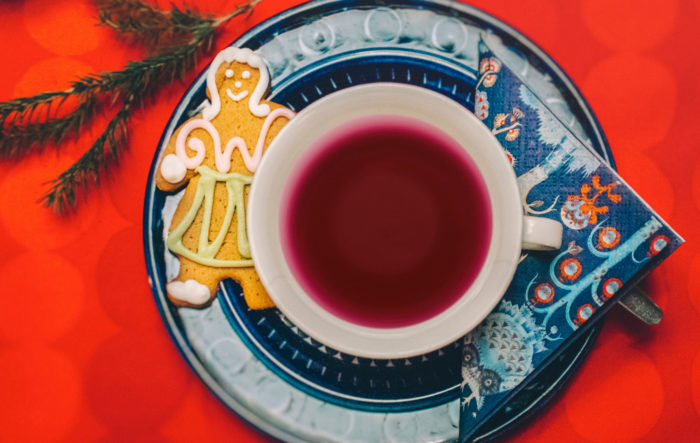
Gingerbread goes great with a hot cup of tea, coffee or mulled wine.
Photo: Jussi Hellstén/Visit Finland
(makes about 200)
Preparation time: 30 minutes
Cooking time: 10 minutes per batch
Oven temperature: 400°F (200 °C)
- 1 1/4 cups (300 g) margarine
- 1 1/4 cups (300 g) sugar
- 3 eggs
- 1 cup (2 1/2 dl) dark syrup
- 2 teaspoons ground cinnamon
- 2 teaspoons ginger
- 2 teaspoons ground cloves
- 1 tablespoon grated orange rind
- about 7 cups (1 kg) white flour
- 3 teaspoons baking soda
1. Boil the syrup and spices, add the margarine and beat until the mixture is cool.
2. Beat the eggs and sugar.
3. Mix the soda in with part of the flour and then combine with the syrup-margarine mixture. Add the whipped eggs and the rest of the flour. Do not knead the final mixture.
4. Cover the dough with plastic wrap and leave overnight in a cool place.
5. Roll out the dough, cut up into shapes and bake the cookies in the oven until golden brown.
Christmas glögg (mulled wine)
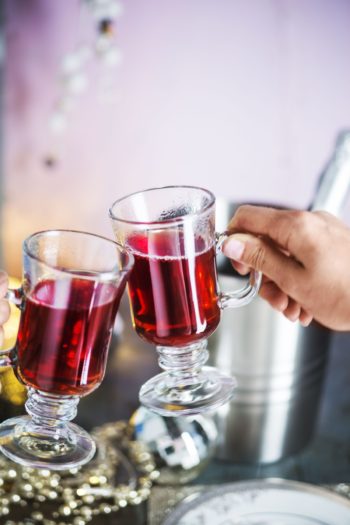
Many events during the holiday season include mulled wine, usually offered in a non-alcoholic version as well.
Photo: Sampo Korhonen/Otavamedia/Lehtikuva
- 1 bottle of red wine
- 2–3 tablespoons Madeira (optional)
- 1/2 cup raw sugar, or to taste
- 1/3 cup raisins
- 1–2 sticks cinnamon
- 5–6 whole cloves
- peelings from an orange
- 1/4 cup blanched, slivered almonds
- 1/4 cup vodka to spike it up (optional)
In a large kettle, combine all the ingredients except the vodka. Heat slowly, until the drink is steaming hot. Stir every now and then, and taste with a spoon whenever you feel like it. Do not let the drink get even close to boiling. Just keep it warm. Before serving, add vodka if you wish. You can also make a non-alcoholic version using grape juice, blackcurrant juice, apple juice, cranberry juice, or a mixture of juices – if so, you can probably leave out the sugar, too.

